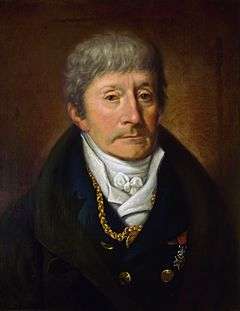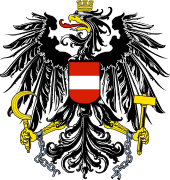Austria–Italy relations
Austria–Italy relations are foreign relations between Austria and Italy. Austria has an embassy in Rome, a general consulate in Milan and 10 honorary consulates (in Bari, Bologna, Florence, Genoa, Naples, Palermo, Trieste, Turin, Venice and Verona). Italy has an embassy in Vienna, a consulate in Innsbruck, and 5 honorary consulates (in Graz, Klagenfurt, Bregenz, Linz and Salzburg).
 | |
Austria |
Italy |
|---|---|
History

Since the Middle Ages, Austria had a great influence over the Italian states, especially in the north of the country. On the other side Italy influenced Austria culture, architecture and cuisine, many artists and architects like Santino Solari, Martino Altomonte, Giovanni Zucalli, Vincenzo Scamozzi worked and contributed to the Baroque in Austria and most notable in Salzburg.[1]

After the Congress of Vienna, Austrian control of the Kingdom of Lombardy-Venetia, with its key cities of Venice and Milan, created the conditions in which Italian nationalism and Austrian interests clashed in the three Wars of Italian Independence between 1848 and 1866 ultimately leading to Italian victory. Tensions remained throughout the 1870s as continued Austrian rule over Italian inhabited lands such as in Trentino and Istria, inflamed Italian nationalism which in turn threatened Austrian integrity; as a result the Austrians built further fortifications along the Italian border.[2] In 1876, the Austrian Archduke Albrecht advocated a preventive war against Italy.[3]
Despite entering into the Triple Alliance of 1882 (along with Germany), areas of clashing interest remained. Italy's improving relations with France, Italian interests in the Balkans, and continuing nationalism among Italians within Austria-Hungary concerned leaders in Vienna. Italy's adherence to the Triple Alliance in the event of war was doubted and from 1903 plans for a possible war against Rome were again maintained by the Austrian general staff.[4] Mutual suspicions led to reinforcement of the frontier and speculation in the press about a war between the two countries into the first decade of the twentieth century.[5] As late as 1911 Count Franz Conrad von Hötzendorf, chief of the Austrian general staff, was advocating a military strike against Austria's supposed Italian allies.[6]
During World War I, Italy fought against Austria–Hungary despite their defensive alliance signed some decades earlier. By World War I's end, Italy emerged victorious and gained new territories from Austria and border agreements were secured.
Today
Both countries are full members of the Organisation for Economic Co-operation and Development and of the European Union. The countries share 420 km of common borders. Austrian Interior Minister Herbert Kickl said on June 5, 2018 that Italy is a strong ally of Austria.[7]
 Palais Matternich in Vienna, seat of the Italian Embassy
Palais Matternich in Vienna, seat of the Italian Embassy Consulate General of Austria in Milan, Italy
Consulate General of Austria in Milan, Italy The President of Austria Alexander Van der Bellen and the President of Italy Sergio Mattarella together with the Governor of South Tyrol Arno Kompatscher and the Mayor of Bolzano Renzo Caramaschi by the Bolzano Transit Camp in 2019
The President of Austria Alexander Van der Bellen and the President of Italy Sergio Mattarella together with the Governor of South Tyrol Arno Kompatscher and the Mayor of Bolzano Renzo Caramaschi by the Bolzano Transit Camp in 2019
See also
References
- "Stile Barocco in Austria" (in Italian). Archived from the original on 2016-03-04. Retrieved 2015-08-06.
- Rothenburg, G. The Army of Francis Joseph. West Lafayette: Purdue University Press, 1976. p 98-99.
- Rothenburg 1976, p. 99.
- Rothenburg 1976, p. 124-25.
- Rothenburg 1976, p. 152.
- Rothenburg 1976, p. 163.
- "Italy big ally - Austria's Kickl (3) - English". ANSA.it. 5 June 2018.


